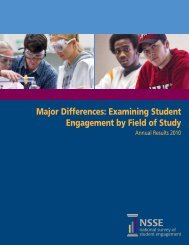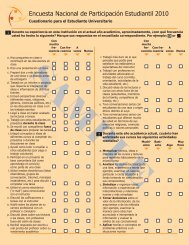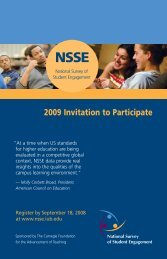Conceptual Framework and Overview of Psychometric Properties
Conceptual Framework and Overview of Psychometric Properties
Conceptual Framework and Overview of Psychometric Properties
You also want an ePaper? Increase the reach of your titles
YUMPU automatically turns print PDFs into web optimized ePapers that Google loves.
Opinions About Your SchoolThese items are on page 3 <strong>of</strong> the instrument<strong>and</strong> represent students= views <strong>of</strong> importantaspects <strong>of</strong> their college=s environment. Thealpha coefficient for these 11 items (includingthe two items on students= overall satisfactionwith college) is .84 (Table 1). Theintercorrelations range between .22 to .65,indicating that all these dimensions <strong>of</strong> thecollege or university environment arepositively related. That is, the degree to whichan institution emphasizes spending time onacademics is not antithetical to providingsupport for academic success or friendly,supportive relations with students <strong>and</strong> facultymembers. At the same time, most <strong>of</strong> thecorrelations are low to moderate in strength,indicating that these dimensions makedistinctive contributions to an institution'slearning environment. Skewness <strong>and</strong> kurtosisindicators are all in the acceptable range.Principal components analysis <strong>of</strong> these itemsproduced three factors (Table 2) accountingfor about 61% <strong>of</strong> the total variance. The firstfactor, Astudent satisfaction with college <strong>and</strong>quality <strong>of</strong> personal relations,@ is made up <strong>of</strong>five items. The second factor is labeledAcampus climate-social@ <strong>and</strong> consists <strong>of</strong> fouritems. The third factor is “campus climateacademic”that consists <strong>of</strong> two items. Thus,students perceive that their institution=senvironment has three related dimensions.The first represents their level <strong>of</strong> satisfactionwith the overall experience <strong>and</strong> theirinteractions with others. The second <strong>and</strong> thethird are broad constructs that reflect thedegree to which students believe theprograms, policies <strong>and</strong> practices <strong>of</strong> theirschool are supportive <strong>and</strong> instrumental in bothsocial <strong>and</strong> academic aspects in helping themattain their personal <strong>and</strong> educational goals.Summary. The pattern <strong>of</strong> responses from firstyearstudents <strong>and</strong> seniors suggest the items aremeasuring what they are supposed to measure.For example, one would expect seniors to be,on average, more engaged in their educationalpursuits compared with first-year students.Seniors would be expected to score higher onmost College Activities items <strong>and</strong> reportingthat their coursework places more emphasison higher order intellectual skills, such asanalysis <strong>and</strong> synthesis as contrasted withmemorization. Among the exceptions is thatseniors reported re-writing papers <strong>and</strong>assignments less frequently than first-yearstudents. This may be because first-yearstudents are more likely to take classes thatrequire multiple drafts <strong>of</strong> papers or becauseseniors have become better writers duringcollege <strong>and</strong> need fewer drafts to produceacceptable written work. On the two otheritems, both <strong>of</strong> which are related to interactingwith peers from different backgrounds, firstyearstudents <strong>and</strong> seniors were comparable.Overall, the items on The Report appear to bemeasuring what they are intended to measure<strong>and</strong> discriminate among students in expectedways.Grades <strong>and</strong> EngagementStudent-reported grade point average (GPA)is positively correlated with the fivebenchmarks, as well as with three additionalscales that measure student-reported gains attheir institution in three areas: generaleducation, practical competence, <strong>and</strong>personal-social growth (See Table 3). Thesepatterns hold for both first-year <strong>and</strong> seniorstudents. These correlations likelyunderstate the link between grades <strong>and</strong>engagement, particularly for seniors,because GPA is cumulative over thestudent’s college career while engagement istypically measured over the current schoolyear. While these analyses cannotdetermine the degree to which engagementpromotes higher grades, or higher gradespromote more intense engagement, theupshot is clear: higher engagement levels<strong>and</strong> higher grades go h<strong>and</strong>-in-h<strong>and</strong>.<strong>Framework</strong> & <strong>Psychometric</strong> <strong>Properties</strong>Page 11 <strong>of</strong> 26



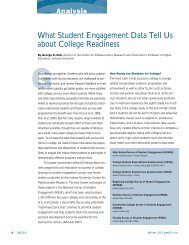

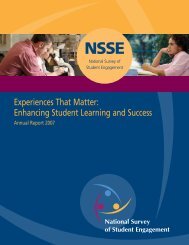
![Cuestionario para el Estudiante Universitarioâ[consent] - NSSE](https://img.yumpu.com/41728892/1/190x245/cuestionario-para-el-estudiante-universitarioaconsent-nsse.jpg?quality=85)
